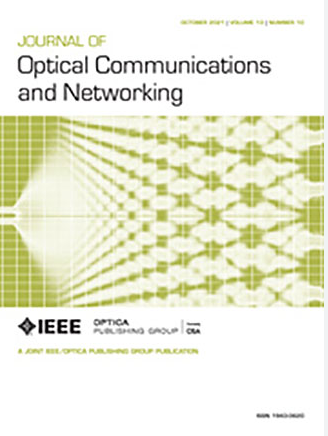速率自适应收发器的物理层感知多波段光网络规划框架
IF 4
2区 计算机科学
Q1 COMPUTER SCIENCE, HARDWARE & ARCHITECTURE
引用次数: 0
摘要
最近,为支持带宽密集型应用日益增长的需求,灵活网格弹性光网络(EON)得到了广泛部署。为了经济高效地扩展网络容量,多频段系统是一种很有前途的解决方案。需要优化 EON 的使用,以延迟成本密集型网络升级,降低成本和功耗。下一代带宽可变收发器(BVT)将通过概率整形(PS)等技术提高符号率和调制的适应性。在这项工作中,我们研究了配置粒度增加对光网络的影响。我们考虑了 BVT 配置的实际实施因素,以估算所需的信噪比。此外,我们还提出了一种优化算法,可为每个考虑的数据速率和带宽组合选择最有效的配置。我们利用先进的传输质量估算建模来评估具有优化发射功率分布的多频段系统中的 PS 配置。我们介绍了在国家和大陆光骨干网拓扑中对 C 波段系统进行网络规划研究的结果,其中考虑到了配置的不同粒度。我们的分析证实,更精细的基于调制的速率自适应可节省大量资源,在 C 波段 EON 中,必要光路的数量最多可减少 13%。在多波段系统中还能观察到更多的节省,显示所需光路的数量进一步增加,最多可节省 20%。相比之下,提高符号率粒度只能节省少量费用。本文章由计算机程序翻译,如有差异,请以英文原文为准。
Physical-layer-aware multi-band optical network planning framework for rate-adaptive transceivers
Flexible-grid elastic optical networks (EONs) have recently been widely deployed to support the growing demand for bandwidth-intensive applications. For cost-efficient scaling of the network capacity, multi-band systems are a promising solution. Optimized utilization of EONs is required to delay cost-extensive network upgrades and to lower cost and power consumption. Next-generation bandwidth-variable transceivers (BVTs) will offer increased adaptivity in symbol rate and modulation through techniques such as probabilistic shaping (PS). In this work, we investigate the impact of increased configuration granularity on optical networks. We account for practical implementation considerations of BVT configurations for estimating the required signal-to-noise ratio. Additionally, an optimization algorithm is presented that selects the most efficient configuration for each considered data rate and bandwidth combination. We utilize advanced quality of transmission estimation modeling to evaluate PS configurations in multi-band systems with optimized launch power distributions. We present results of network planning studies for C-band systems in a national and a continental optical backbone network topology considering different granularities of the configurations. Our analysis confirms that finer modulation-based rate-adaptivity results in substantial resource savings, decreasing the number of necessary lightpaths by at most 13% in C-band EONs. Additional savings are observed in multi-band systems, showing further increased savings in the number of required lightpaths of up to 20%. In contrast, increased symbol rate granularity only results in minor savings.
求助全文
通过发布文献求助,成功后即可免费获取论文全文。
去求助
来源期刊
CiteScore
9.40
自引率
16.00%
发文量
104
审稿时长
4 months
期刊介绍:
The scope of the Journal includes advances in the state-of-the-art of optical networking science, technology, and engineering. Both theoretical contributions (including new techniques, concepts, analyses, and economic studies) and practical contributions (including optical networking experiments, prototypes, and new applications) are encouraged. Subareas of interest include the architecture and design of optical networks, optical network survivability and security, software-defined optical networking, elastic optical networks, data and control plane advances, network management related innovation, and optical access networks. Enabling technologies and their applications are suitable topics only if the results are shown to directly impact optical networking beyond simple point-to-point networks.

 求助内容:
求助内容: 应助结果提醒方式:
应助结果提醒方式:


